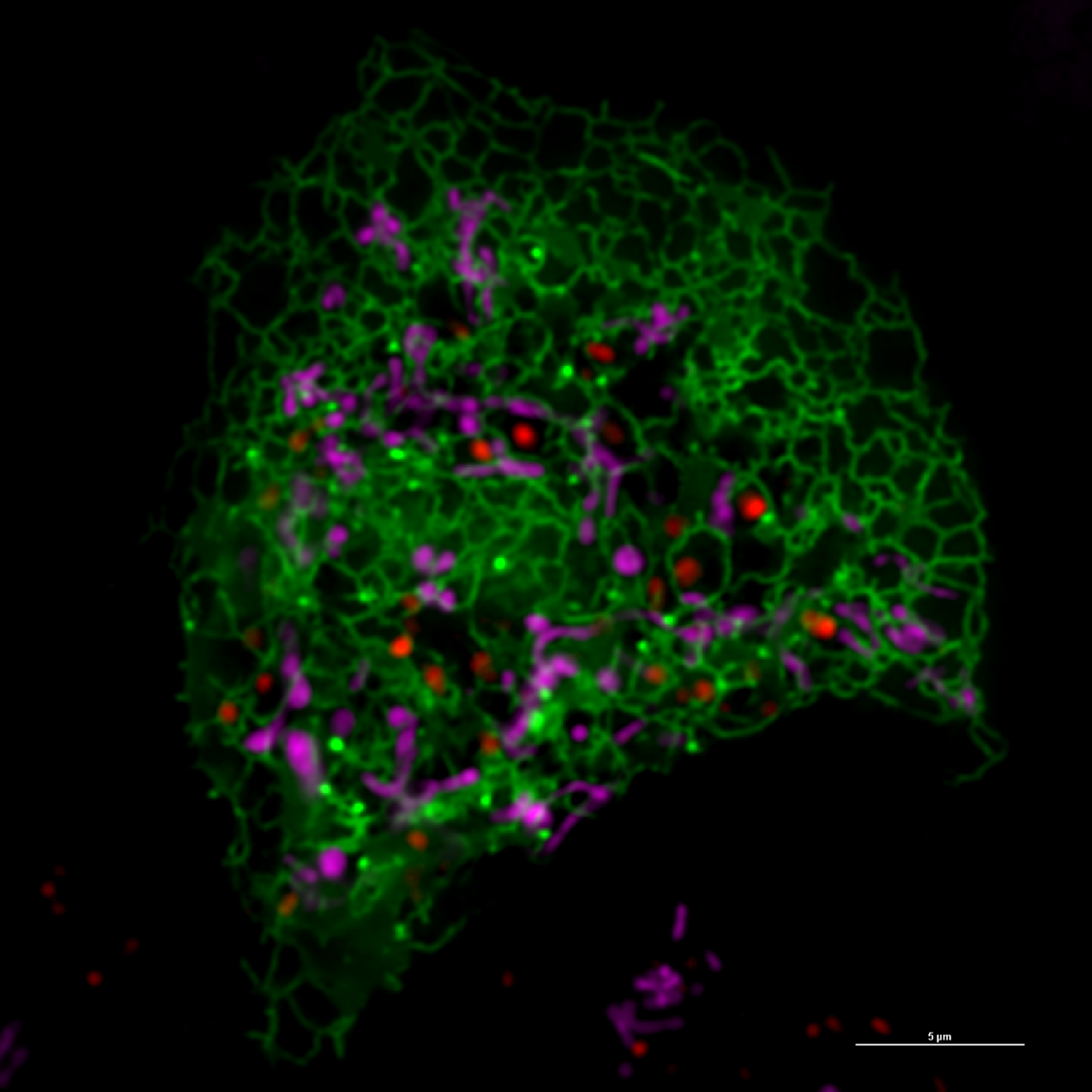Initial results from a new study at the University of Cincinnati point to the possibility of using light to treat several diseases, including cancer.
 A super resolution image captured in Diao's lab shows the endoplasmic reticulum in green, lysosomes in pink and mitochondria in red. Using the light-activated proteins, the mitochondria and lysosomes are brought together to conduct mitochondrial fission. Image Credit: Jiajie Diao
A super resolution image captured in Diao's lab shows the endoplasmic reticulum in green, lysosomes in pink and mitochondria in red. Using the light-activated proteins, the mitochondria and lysosomes are brought together to conduct mitochondrial fission. Image Credit: Jiajie Diao
On July 25th, 2022, scientists from the University of California, the University of Illinois Urbana-Champaign, and the University at Buffalo released the findings of their study, revealing how light-activated proteins can help normalize cellular abnormalities.
Research Findings
The study focuses on the roles played by mitochondria, which are the cell’s “power plant” and primary energy source. Small, specialized structures called organelles carry out a variety of tasks inside cells.
One of the study’s authors, Jiajie Diao, Ph.D., said that hundreds of mitochondria regularly fuse together and fragment into smaller pieces to maintain equilibrium in healthy cells. However, this fission and fusion process is out of balance when mitochondria are not working properly.
Numerous mitochondrial disorders, including neurological conditions like dementia and certain malignancies, can develop as a result of this imbalance.
According to Diao’s earlier studies, the lysosome, a different organelle found in cells, can contribute to the fission of mitochondria. The lysosome can behave like a pair of scissors and cut the mitochondria into smaller pieces when it comes into contact with them.
The current study concentrated on bringing together lysosomes and mitochondria within cells to kick-start the fission process. Optogenetics, a method used to precisely regulate particular cell processes using light, was used to achieve this.
Many proteins in plants are light sensitive, informing plants whether it is day or night. Optogenetics borrows these light-sensitive proteins from plants and uses them in animal cells. By attaching such proteins to organelles, one can use light to control the interaction between them, such as mitochondria and lysosomes shown in this work.
Kai Zhang, Study Co-Author and Associate Professor, University of Illinois Urbana-Champaign
Using blue light, he developed optogenetic tools to regulate mitochondria and lysosomes.
Two distinct proteins were connected by the researchers to the lysosomes and mitochondria in stem cells. The proteins spontaneously attach to one another when triggered by blue light to create a single new protein, which also brings the mitochondria and lysosome into contact. When they are together, the lysosome can slice the mitochondria to induce fission.
We found that it can recover the mitochondrial function. Some of the cells can even go back to normal. This proves that by just using some simple light stimulation we can at least partially recover the mitochondrial function of the cell.
Jiajie Diao, Associate Professor, Department of Cancer Biology, UC’s College of Medicine
According to Diao, this technique could be particularly helpful for individuals whose drastically enormous mitochondria need to be broken into smaller pieces for the cells to operate normally. The technique might potentially be used to treat cancer cells by repeatedly cutting apart the mitochondria until they are no longer able to function.
Diao stated, “Eventually the cancer cells will be killed because mitochondria is their energy. Without normal functional mitochondria, all of the cancer cells will be killed.”
Diao pointed out the fact that the proteins being light-activated offers a more specialized approach to certain cells. The technique does not influence the mitochondria of neighboring healthy cells since it only affects cells that are exposed to light.
Other methods for inducing mitochondrial fission are now available, but Diao said that the optogenetic method is safer since it does not use chemicals or hazardous substances.
Diao concluded, “What we have is actually the natural process, we are just making it faster. So, it is not like a chemical or a therapy or a radiotherapy where you need to reduce the side effects.”
Next Steps
Diao and his team are already working on employing the same technology to promote fusion to solve problems caused by mitochondria that are out of balance since they are too small and are not fusing together properly within cells.
Since a longer wavelength will be required to reach human tissue, additional research from Zhang’s group will also focus on creating new optogenetic devices that use multiple hues of light, including green, red, and infrared.
Zhang added, “We would like to further expand the toolbox by introducing multicolor optogenetic systems to give us multiple ways to control how organelles behave and interact. For instance, one color makes organelles come together, while the other color forces them apart. This way, we can precisely control their interactions.”
The team intends to advance its current work with human stem cells to assess the technique’s effectiveness using animal models before ultimately testing it on humans through clinical trials. Diao also noted that other research teams are investigating the use of magnetic fields and acoustic vibrations rather than light to achieve comparable outcomes.
The National Institutes of Health provided funding for this research (NIH R35GM128837 and R21AG061600 to J.D.; R01GM132438 and R01MH124827 to K.Z.). The writers claim they have no conflicting interests.
Journal Reference:
Qiu, K., et al. (2022) Light-activated mitochondrial fission through optogenetic control of mitochondria-lysosome contacts. Nature Communications. doi:10.1038/s41467-022-31970-5.